Sanjib Kumar Agarwalla was recently awarded the 2021-2022 Rajib Goyal Prize in Physical Sciences, which “honors Indian scientists who have made a mark in basic and applied sciences research.” The Goyal Prizes were instituted by the late philanthropist Ram S. Goyal to honor Indian scientists and social activists working towards the service of India. Agarwalla [...]
Read the full article at: https://wipac.wisc.edu/sanjib-kumar-agarwalla-receives-prestigious-2021-2022-rajib-goyal-prize/WIPAC
WIPAC, UW–Madison Physics Department host after-school program
Last week, 23 participants and their family members gathered for an evening of presentations and cake as part of IceCube After School, an eight-week program hosted by the Wisconsin IceCube Particle Astrophysics Center (WIPAC). Since 2013, the annual program introduces local high school students to WIPAC research and the people who make it possible. For [...]
Read the full article at: https://wipac.wisc.edu/wipac-uw-madison-physics-department-host-after-school-program/Ke Fang named Sloan Fellow
This story is adapted from one published by University Communications
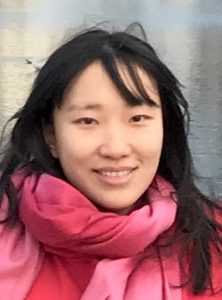
Ke Fang, assistant professor of Physics and WIPAC investigator, is among 126 scientists across the United States and Canada selected as Sloan Research Fellows.
The fellowships, awarded annually since 1955, honor exceptional scientists whose creativity, innovation and research accomplishments make them stand out as future leaders in their fields.
Using data from the Ice Cube Observatory and Fermi Large Area Telescope along with numerical simulations, Fang studies the origin of subatomic particles — like neutrinos — that reach Earth from across the universe.
“Sloan Research Fellowships are extraordinarily competitive awards involving the nominations of the most inventive and impactful early-career scientists across the U.S. and Canada,” says Adam F. Falk, president of the Alfred P. Sloan Foundation. “We look forward to seeing how fellows take leading roles shaping the research agenda within their respective fields.”
Founded in 1934, the Sloan Foundation is a not-for-profit institution dedicated to improving the welfare of all through the advancement of scientific knowledge.
Sloan Fellows are chosen in seven fields — chemistry, computer science, Earth system science, economics, mathematics, neuroscience and physics — based on nomination and consideration by fellow scientists. The 2024 cohort comes from 53 institutions and a field that included more than 1,000 nominees. Winners receive a two-year, $75,000 fellowship that can be used flexibly to advance their research.
Among current and former Sloan Fellows, 57 have won a Nobel Prize, 71 have been awarded the National Medal of Science, 17 have won the Fields Medal in mathematics and 23 have won the John Bates Clark Medal in economics.
Xiangyao Yu, assistant professor of computer sciences at UW–Madison, was also named a Sloan Fellow.
First field season for IceCube Upgrade ongoing at the South Pole
Over the past two months, a team of IceCube drill engineers have completed an impressive amount of work during the first of three consecutive field seasons for the IceCube Upgrade. The project is funded by the National Science Foundation and international collaborators.
The goal of the project is to drill seven holes in 2025/2026 and deploy seven more closely spaced and more densely instrumented strings of sensors in the central part of the array, which will improve IceCube’s sensitivity to low energies. Having a productive first field season both sets the Upgrade project up for success and trains the new generation of drillers at the South Pole.
The majority of the team’s engineers come from the University of Wisconsin–Madison’s Physical Sciences Laboratory (PSL), where equipment is fabricated and shipped to the South Pole. Additional drill engineers hail from Sweden, New Zealand, and for the first time, Thailand.
“This year’s drill team is a group of 17 talented professionals who have completed an enormous amount of work,” says Kurt Studt, drill engineer at PSL and the on-ice drill manager for the Upgrade. “We’ve overcome many difficult challenges while dealing with the extreme environment at the South Pole, including temperatures as low as -35 ⁰F and windchills below -60 ⁰F.”

Federal physics advisory panel — including Profs. Bose and Cranmer — announces particle physics recommendations
Earlier this year, physics professors Tulika Bose and Kyle Cranmer were selected to serve on the Particle Physics Project Prioritization Panel, or P5, a group of High Energy Physics experts that advises the Department of Energy Office of Science and the National Science Foundation’s Division of Physics on high energy and particle physics matters.
P5 announced their recommendations in a draft report published Dec. 7 — and UW–Madison physicists are featured in many of the projects.
One recommendation is to move forward with a planned expansion of the IceCube Neutrino Observatory, an international scientific collaboration operated by the UW–Madison at the South Pole. Other recommendations include support for a separate neutrino experiment based in Illinois (the Deep Underground Neutrino Experiment, or DUNE); continuing investment in the Large Hadron Collider in Switzerland and the Rubin Observatory in Chile; and expanding involvement in the Cherenkov Telescope Array (CTA), a ground-based very-high-energy gamma ray observatory. UW–Madison physicists have leading roles in all of these research efforts.
Additional recommendations include the development of a next generation of ground-based telescopes to observe the cosmic microwave background and a direct dark matter detector experiment, among others.
Lu Lu receives 2023 IUPAP Early Career Scientist Prize
This story was originally posted by WIPAC
IceCube collaborator and UW–Madison assistant professor of physics Lu Lu received a 2023 International Union of Pure and Applied Physics (IUPAP) Early Career Scientist Prize “for her contributions to the development of high energy neutrino astronomy in the PeV energy region.” Lu accepted the award on July 27 during the opening ceremony at the 38th International Cosmic Ray Conference (ICRC) held in Nagoya, Japan.
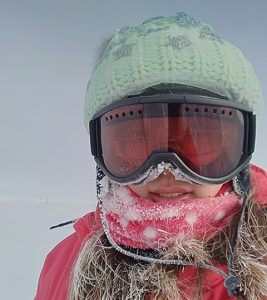
Early Career Scientist Prizes are given to early career scientists within each IUPAP commission who have up to eight years of postdoctoral research experience and have made significant contributions to the cosmic ray field. Lu is a recipient of the Early Career Scientist Prize in the Commission on Astroparticle Physics (C4).
Her PhD work focused on developing a novel technique to search for ultra-high-energy photons using data from the Pierre Auger Observatory. She also played a leading role in the initial design of the “Dual optical sensors in an Ellipsoid Glass for Gen2” (D-Egg), a two-PMT optical module for the IceCube Upgrade.
More recently, she made key contributions to the multimessenger correlation studies of the neutrino source candidate TXS0506+056 and to the detection of a particle shower associated with the hadronic decay of a resonant W boson.
Lu is currently an assistant professor of physics at the Wisconsin IceCube Particle Astrophysics Center (WIPAC) at the University of Wisconsin–Madison. Her current research focuses on diffuse high-energy astrophysical/cosmogenic neutrinos from TeV to EeV, Galactic PeVatron detection in the context of multimessenger observations, and the exploration of potential transient ultra-high-energy sources.
She is actively involved in IceCube outreach initiatives and has pioneered the development of an app that provides IceCube real-time alerts via augmented reality on mobile devices. Currently, she serves as co-lead of the diffuse science working group in IceCube and is one of three representatives of the physical science group of US-SCAR (Scientific Committee of Antarctic Research).
“I would like to express my deep appreciation for my collaborators and for those who work on foundational tasks such as reconstructions and calibrations, as their efforts behind the scenes make groundbreaking discoveries possible,” said Lu. “As early career scientists, we bear the responsibility of continuing and expanding experiments in the particle astrophysics field. We must collaborate and work together to ensure that the next generation of young scientists will have exciting discoveries to make.”
IceCube shows Milky Way galaxy is a neutrino desert
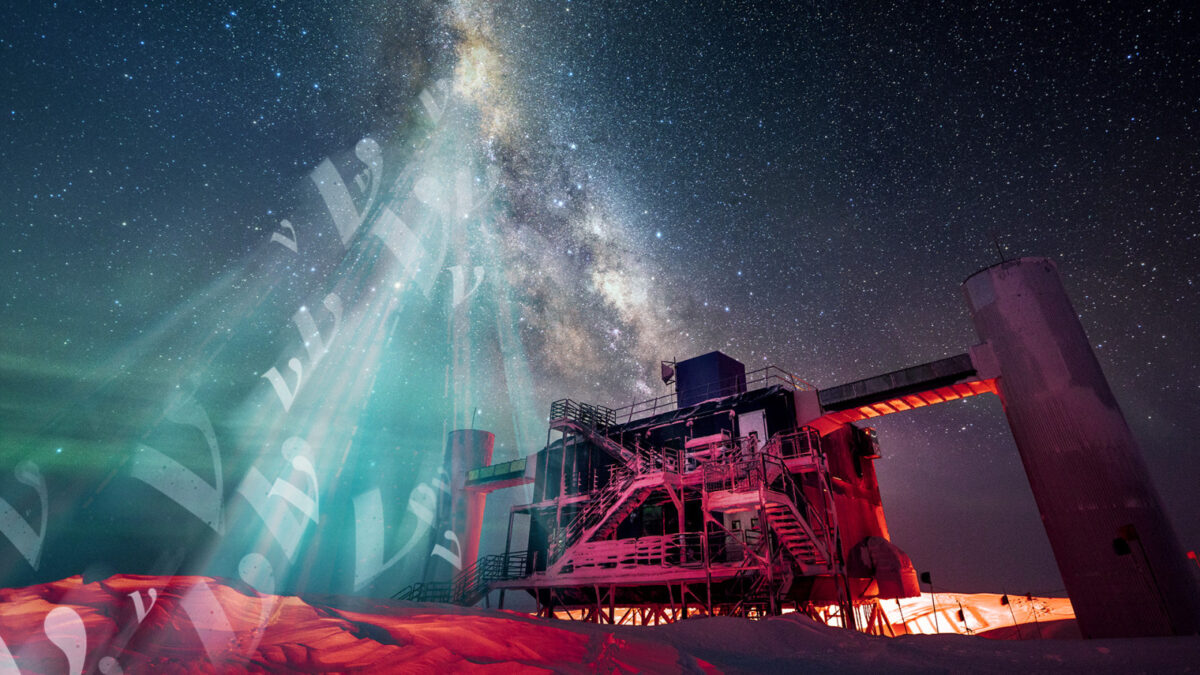
The Milky Way galaxy is an awe-inspiring feature of the night sky, dominating all wavelengths of light and viewable with the naked eye as a hazy band of stars stretching from horizon to horizon. Now,
In a June 30 article in the journal Science, the IceCube Collaboration — an international group of more than 350 scientists — presents this new evidence of high-energy neutrino emission from the Milky Way. The findings indicate that the Milky Way produces far fewer neutrinos than the average distant galaxies.
“What’s intriguing is that, unlike the case for light of any wavelength, in neutrinos, the universe outshines the nearby sources in our own galaxy,” says Francis Halzen, a professor of physics at the University of Wisconsin–Madison and principal investigator at IceCube.
The IceCube search focused on the southern sky, where the bulk of neutrino emission from the galactic plane is expected near the center of the galaxy. However, until now, a background of neutrinos and other particles produced by cosmic-ray interactions with the Earth’s atmosphere made it difficult to parse out neutrinos originating from galactic sources — a significant challenge compounded by relatively sparse neutrino production in general.
Big discoveries, lofty goals highlight astronomy Investiture panel
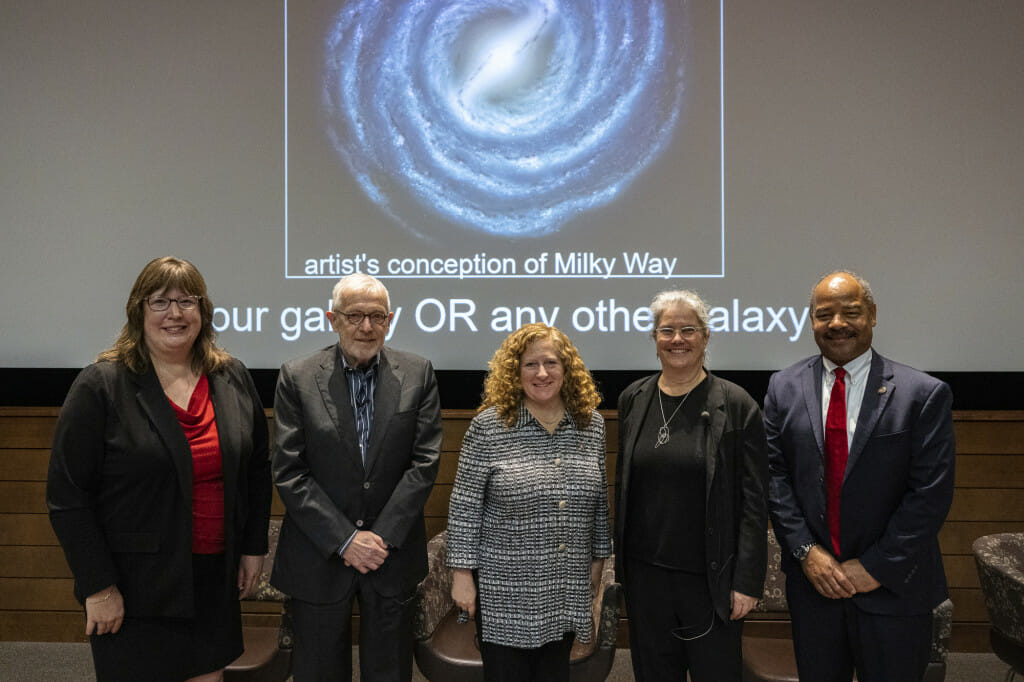
This story was originally published by University Communications as part of their coverage of Chancellor Mnookin’s Investiture
A group of astronomers and physicists, including Physics professor Francis Halzen, shared the stories behind their groundbreaking discoveries and lofty goals before a packed house gathered at University of Wisconsin–Madison’s Marquee Theater on Thursday to celebrate the Investiture of Chancellor Jennifer Mnookin.
The scientists included UW–Madison professors Francis Halzen and Susanna Widicus Weaver, as well as Andrea Ghez, a professor at the University of California, Los Angeles and good friend of Chancellor Mnookin. The symposium was titled “Discovery Past, Present, and Future: Black Holes, Neutrinos, and Life in our Galaxy.”
The friendship between Mnookin and Ghez goes back more than 15 years and is filled with fond memories, among them a champagne toast they shared in Ghez’s backyard to mark her winning the 2020 Nobel Prize in Physics. An attorney with a skill for interpreting legalese, Mnookin ensured the celebratory moment would conform with California’s emergency public health rules during the first winter of the COVID-19 pandemic.
“One of the things I love about Chancellor Mnookin is she is a problem solver,” said Ghez, who shared the 2020 prize for the discovery of a supermassive black hole at the center of the Milky Way galaxy.
Ghez recounted the scientific principles, theories and observations that led to the discovery in a talk that reveled in the surprise of the scientific process — a process that is increasingly enabled by new technologies.
“What’s so fun about what I call ‘technology-enabled discovery’ is that almost everything we’ve been able to look at in the center of the galaxy and its environment is inconsistent with the predictions,” Ghez said. “I like to call that either job security or being a kid in a candy shop.”
The rise of new technologies to help answer fundamental questions about the universe was a common theme among the three panelists, who were introduced by Dean Eric Wilcots of the College of Letters & Science and an astronomer himself.
Halzen described the massive telescope built deep within the ice at UW’s IceCube Neutrino Observatory at the South Pole that has enabled the detection of neutrinos, along with plans for an ice-encased observatory 10 times its size. The ghostly particles zip across the universe unimpeded from high-energy sources like the supermassive black holes now believed to be at the center of virtually all large galaxies.
And Widicus Weaver recounted her work hunting for the chemical signatures that might help identify habitable exoplanets — research that has received a massive boost from the James Webb Space Telescope, which began its science mission less than a year ago.
The discussion began with a history lesson provided by Wilcots, who shared the story of Karl Jansky.
A 1927 graduate of UW–Madison who was known at the time as “the fastest skater on the Wisconsin hockey team,” Jansky went on to work for Bell Laboratories. There he sought to understand the sources of static and radio interference — work that eventually led Jansky to observe a major source of radio interference emanating from the constellation of Sagittarius. Decades later, Ghez discovered the likely source — the supermassive black hole at the center of the galaxy.
Jansky’s observations “effectively started the field of radio astronomy,” Wilcots said, noting UW–Madison’s prominent and ongoing contributions to the field via scientists like Halzen, Widicus Weaver and their many colleagues.
The contributions are in their own ways manifestations of the Wisconsin Idea, Mnookin said in her opening remarks.
“When we talk about the Wisconsin Idea and our impact beyond the borders of our campus, it is awesome to think that there are people in our midst pushing that line beyond our planet, our solar system and even our galaxy,” she said.
IceCube search for sub-TeV neutrino emission associated with LIGO/Virgo gravitational waves
Gravitational waves (GWs) are produced by some of the most extreme astrophysical phenomena, such as black hole and neutron star mergers. They have long been suspected as astrophysical sources of neutrinos, ghostlike cosmic messengers hurtling through space unimpeded. Thus far, common astrophysical sources of neutrinos and photons, as well as common sources of gravitational waves and light, have been identified. However, no one has yet detected sources that emit both gravitational waves and neutrinos.
In a study recently submitted to The Astrophysical Journal, the IceCube Collaboration performed a new search for neutrinos from GWs at the GeV-TeV scale. Although no evidence of neutrino emission was found, new upper limits on the number of neutrinos associated with each gravitational wave source and on the total energy emitted by neutrinos for each source were set.
Previously, IceCube searched for neutrinos from GW sources using the TeV-PeV neutrinos detected by the main IceCube Neutrino Observatory, a cubic-kilometer detector enveloped in Antarctic ice at the South Pole. This time, collaborators used data taken with the DeepCore array, the innermost component of IceCube consisting of sensors more densely spaced than in the main array. DeepCore can detect lower energy (GeV and upward) neutrinos than is possible with the larger main array.
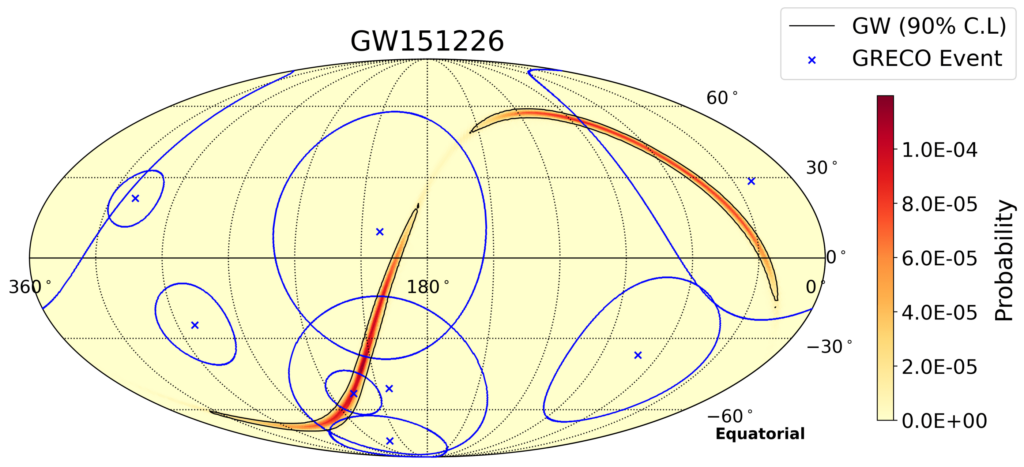
The analysis looked for temporal and spatial correlations between 90 GW events detected by the Laser Interferometer Gravitational-Wave Observatory (LIGO) and the Virgo gravitational wave detectors and neutrinos detected by DeepCore. The researchers found no significant excess of neutrinos from the direction of the GW events but set stringent upper limits on the neutrino flux and limits on the energies associated with neutrinos from each GW source.
“These results do not mean that all hope is lost for detecting such joint emissions,” says Aswathi Balagopal V., a postdoctoral associate at UW–Madison and co-lead of the analysis. “With improvements in directional reconstructions for low-energy neutrinos, which is expected with better methods and with the inclusion of the IceCube Upgrade, we will be able to achieve better sensitivities for such joint searches, potentially leading to a positive discovery.”
UW–Madison researchers key in search for neutrino emission from the brightest gamma-ray burst ever detected
This story was originally published by WIPAC
On October 9th, 2022, an unusually bright pulse of high-energy radiation whizzed past Earth, captivating astronomers around the world. The luminous emission came from a gamma-ray burst (GRB), one of the most powerful classes of explosions in the universe. Named GRB 221009A, it triggered detectors at NASA’s Gamma-ray Burst Monitor and Large Area Telescope (both on board the Fermi Gamma-ray Space Telescope), the Neil Gehrels Swift Observatory, and the Wind spacecraft as well as other telescopes that quickly turned to the GRB site to study its aftermath.
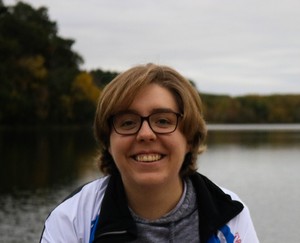
This record-shattering GRB is one of the closest and the brightest GRB ever spotted, earning it the nickname BOAT (“brightest of all time”). This GRB is believed to come from an exploding star and likely signals the birth of a black hole.
In a new study by the IceCube Collaboration, published today in The Astrophysical Journal Letters, UW–Madison researchers presented results of one of five searches for neutrino emission from GRB 221009A that leveraged the full detector range, covering nine orders of magnitude in energy. Because no significant emission was found across samples spanning 10 MeV to 10 PeV, the results are the most stringent constraints on neutrino emission from GRBs.
As some of the most energetic sources in the universe, GRBs have long been considered a possible astrophysical source of neutrinos—tiny “ghostlike” particles that travel through space and large amounts of matter unhindered. These high-energy neutrinos are of particular interest to the National Science Foundation-supported IceCube Neutrino Observatory, a gigaton-scale neutrino detector at the South Pole.
IceCube is run by the international IceCube Collaboration, which comprises over 350 scientists from 58 institutions around the world. The Wisconsin IceCube Particle Astrophysics Center (WIPAC), a research center at UW–Madison, is the lead institution for the IceCube project.
Previously, IceCube has performed searches for neutrino emission from GRBs, but thus far, a correlation has not been found between high-energy neutrinos and GRBs. The recent observation of GRB 221009A presented IceCube with the best opportunity yet to search for neutrino emission by GRBs.

“Not only was this GRB the brightest ever detected in gamma rays, it also occurred in a region of the sky where IceCube is very sensitive,” says UW–Madison physics professor Justin Vandenbroucke, who helped lead the analysis.
For the study, collaborators carried out five complementary IceCube analyses that encompassed the full energy range of the detector. Each analysis targeted a specific energy range, with the idea of covering as wide an energy range as possible. UW–Madison physics PhD student Jessie Thwaites was one of the main analyzers.
Thwaites performed a “fast response” analysis based on real-time data from the South Pole to search for high-energy (0.10 teraelectronvolts to 10 petaelectronvolts) neutrinos from the direction of the GRB. They chose two time windows: one three-hour window covering all of the triggers reported in real time, and one covering two days. Their analysis, which set strong constraints on neutrino emission from GRBs, was quickly reported to the community, within hours of the GRB being detected by the gamma-ray satellites.
“In the high energies, our upper limits are very constraining—they are below the observations from gamma-ray telescopes,” says Thwaites. “These upper limits, combined with the observations from many electromagnetic telescopes, give us more information about GRBs as potential particle accelerators.”
Because this GRB is so bright, and because it has been so well studied, IceCube is able to place constraining upper limits on neutrino emission models proposed for this specific GRB. These constraints will enable better understanding of how GRBs work.
The collaborators are already developing new methods to improve searches for neutrinos from GRBs and other transient astrophysical sources. In addition, future upgrades and proposed extensions of IceCube, including the IceCube Upgrade project and IceCube-Gen2, could be the key to finding high-energy neutrino emission from GRBs or other transients.
According to Vandenbroucke, “This GRB illustrates the capabilities of IceCube for real-time follow-up of astrophysical transients. IceCube views the entire sky, all the time, over a factor of a billion in energy range. There is likely a burst of neutrinos already flying towards us from some other cosmic source, and we are ready for it.”
+ info “Limits on Neutrino Emission from GRB 221009A from MeV to PeV using the IceCube Neutrino Observatory,” The IceCube Collaboration: R. Abbasi et al. Published in The Astrophysical Journal Letters. arxiv.org/abs/2302.05459